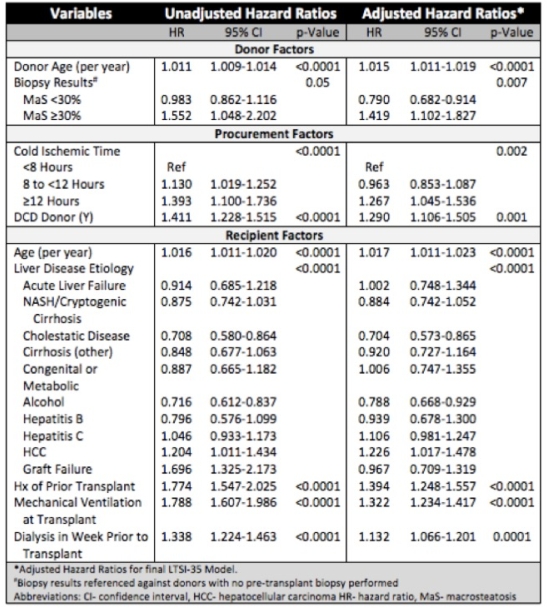Liver Transplant Survival Index for Recipients with High MELD Score: A Model for Post-Transplant Survival in Severely Ill Patients
1Surgery, Cedars-Sinai Medical Center, Los Angeles, CA
2Biostatistics, Cedars-Sinai Medical Center, Los Angeles, CA
3Surgery, Oregon Health Science University, Portland, OR.
Meeting: 2018 American Transplant Congress
Abstract number: 467
Keywords: Graft survival, Liver transplantation, Multivariate analysis
Session Information
Session Name: Concurrent Session: Liver: MELD, Allocation and Donor Issues - 2
Session Type: Concurrent Session
Date: Tuesday, June 5, 2018
Session Time: 2:30pm-4:00pm
 Presentation Time: 2:42pm-2:54pm
Presentation Time: 2:42pm-2:54pm
Location: Room 6B
Background: SHARE-35 prioritizes patients with MELD scores ≥35 for regional sharing of liver allografts. Because this policy incentivizes transplantation of sicker patients, this study examines graft survival in the MELD ≥35 population.
Methods: Analysis of UNOS STAR database identified 7,397 adult liver transplant (LT) recipients with MELD ≥35 between January 2006 and June 2016. Factors affecting graft survival were evaluated by Cox proportional hazards analysis. Regression coefficients were used to generate Liver Transplant Survival Index (LTSI-35).
Results: Four risk groups were identified by LTSI-35 quartiles, correlating with Low, Moderate, High, and Severe Risk. Donors' age, graft macrosteatosis ≥30%, donation after cardiac death, cold ischemic time; and recipients' age, liver disease etiology, prior transplant, mechanical ventilation dependence, and dialysis at transplant were significant factors affecting graft survival.  Risk groups predicted 25% graft failures at 2693, 1416, 763, and 277 days
Risk groups predicted 25% graft failures at 2693, 1416, 763, and 277 days  (p<0.001). One-year graft survival was 89.0% in Low-Risk group vs 68.7% in Severe-Risk group (p<0.001); 3-year graft survival ranged from 81.3% to 52.1% in Low- and Severe-Risk groups, respectively (p<0.001). No significant differences existed between test and validate groups for graft survival at any time point within risk groups.
(p<0.001). One-year graft survival was 89.0% in Low-Risk group vs 68.7% in Severe-Risk group (p<0.001); 3-year graft survival ranged from 81.3% to 52.1% in Low- and Severe-Risk groups, respectively (p<0.001). No significant differences existed between test and validate groups for graft survival at any time point within risk groups.
Conclusion: LTSI-35 reflects the risk of transplantation in high-MELD recipients and supports the use of high-risk donor-recipient pairs. Clinically, LTSI-35 may better inform expected outcomes and aid in graft selection for severely ill recipients to maximize outcomes.
CITATION INFORMATION: Steggerda J., Bloom M., Bresee C., Malinoski D., Klein A., Kim K. Liver Transplant Survival Index for Recipients with High MELD Score: A Model for Post-Transplant Survival in Severely Ill Patients Am J Transplant. 2017;17 (suppl 3).
To cite this abstract in AMA style:
Steggerda J, Bloom M, Bresee C, Malinoski D, Klein A, Kim K. Liver Transplant Survival Index for Recipients with High MELD Score: A Model for Post-Transplant Survival in Severely Ill Patients [abstract]. https://atcmeetingabstracts.com/abstract/liver-transplant-survival-index-for-recipients-with-high-meld-score-a-model-for-post-transplant-survival-in-severely-ill-patients/. Accessed December 15, 2025.« Back to 2018 American Transplant Congress
